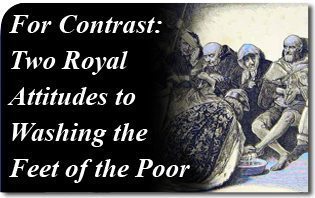 In February, Philip II returned to Castile arriving in time to observe Holy Week at San Lorenzo and to wash the feet of the poor on Holy Thursday “with his usual great tenderness and humility.”
In February, Philip II returned to Castile arriving in time to observe Holy Week at San Lorenzo and to wash the feet of the poor on Holy Thursday “with his usual great tenderness and humility.”
On Good Friday he adored the wood of the True Cross and pardoned several men who had been condemned to death, bowing down to adore “the sacred wood where our Redemption was accomplished, and begging the King of Kings Who placed Himself there for our good, to pardon him his sins as he forgave those deaths.” Then he went to confession. On Easter Sunday he received Holy Communion with great devotion and gained the plenary indulgence granted by Pope Gregory XIII and then went back to Madrid to attend to his ordinary business.
Every Maundy Thursday Queen Elizabeth I continued to wash the feet of beggars as her sister had done. Under the outer husk of the new political Church of England was her symbolic and shriveling Catholic spirit. She disdained to touch the feet of the poor wretches until they had first been scrubbed with hot water and soap and well sprinkled with sweet-smelling herbs by yeomen of the laundry.
Contrary to this, Philip II continued to abase himself before the common human clay as Christ had done. So long as Spain had kings, there would be such reminders of the unchanging truth of Christianity. The kings of England would end by not washing the feet of the poor at all but dolled out a few coins instead. For them, it was only an imaginary Christianity, a travesty, that Elizabeth clung to, half-despisingly.
William Thomas Walsh, Philip II (Rockford, Ill.: Tan Books and Publishers, Inc., 1987), pp. 615, 295.

